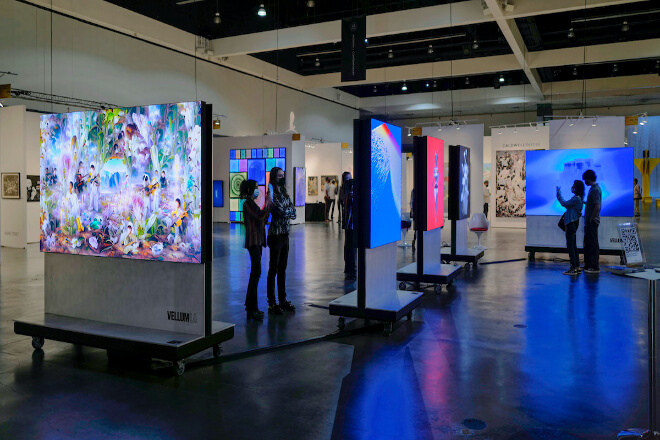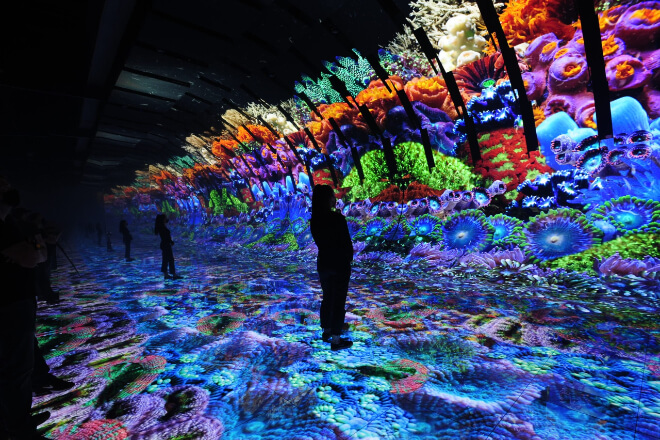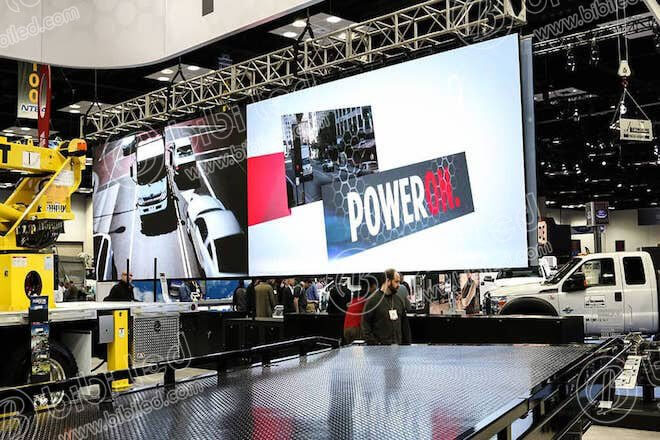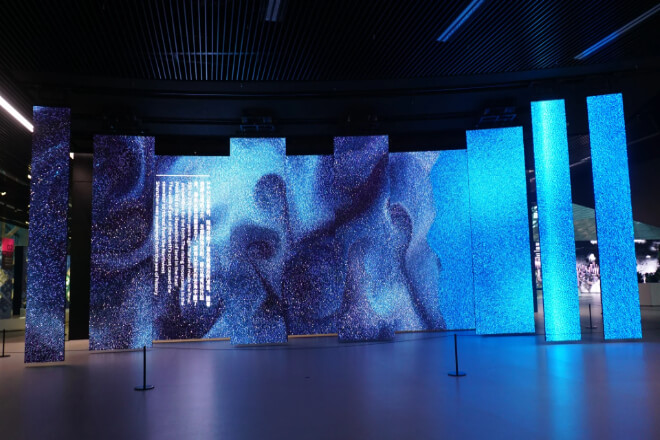Introduction

Have you ever been to an art exhibition and been captivated by the high-tech displays?
For example, a painting animates on the screen, or the entire space transforms with your movements – it’s like being transported to another world.
This eye-opening feeling is largely due to LED displays.
Table of Contents
1. The Importance of Visual Impact in Art

In art, visual impact is like a work’s “first-second calling card.” It’s not just beautiful or stunning; it instantly captures your attention, compelling you to stop and take a closer look.
A painting with strong color contrast, a sculpture of exaggerated scale, or even an installation that suddenly appears in an ordinary scene can all be eye-catching.
This immediate “grabbing” effect is the most direct effect of visual impact.
Even more interestingly, visual impact can directly touch people’s emotions, without requiring a second thought. Sharp contrasts in color, light, shadow, and shape can instantly elicit a response.
For example, the passion evoked by red, the sense of distance created by cool tones, or even an unexpected shift in form can all evoke an “Ah, what is this?” emotion.
This instant resonance is faster, more direct, and more memorable than a textual description.
Visual impact can also help a work convey its theme more clearly. Many artists use large canvases, repetitive symbols, or immersive spaces to amplify the ideas within their work, making them almost impossible to ignore.
For example, LED screen installations or interactive spaces in contemporary exhibitions can envelop the viewer as soon as they enter.
This direct experience helps the work retain its message more vividly than simply reading a textual description.
Thus, the enduring power of some classic artistic symbols is largely due to their visual impact. Yayoi Kusama’s polka dots, Andy Warhol’s pop colors, and Picasso’s Cubist paintings—they’re instantly memorable.
You might forget the date of an exhibition, but you can easily remember the visual experience that captivated you.
In short, visual impact isn’t the be-all and end-all of art, but it is the key to making people stop and truly experience the work.
Only by catching the eye can one touch the heart, and only by touching the heart can the work truly begin to speak.
2. Applications of LED Displays in Different Types of Art Exhibitions
1) Painting Exhibitions: Enhancing Details and Storytelling
In traditional painting exhibitions, LED displays not only showcase the artwork itself but also magnify details, allowing viewers to see brushstrokes and textures that are difficult to perceive with the naked eye.
For example, when some Impressionist paintings are magnified on an LED screen, viewers can clearly see the painter’s thick layers of paint, as if they can touch the texture of the canvas.
In addition, the screens can also play videos of the creative process or artist explanations, bringing static works to life.
Viewers can not only see the surface of the work but also understand the story and creative process behind it.
2) Sculpture and Installation Art Exhibitions: Creating an Immersive Atmosphere
In sculpture or installation art exhibitions, LED displays are often used to enhance the sense of space and interactive experiences.
Wall or floor screens can project light and shadow, creating a dynamic visual interaction with the sculpture.
For example, in exhibitions by Japanese artist teamLab, LED displays are integrated with spatial installations.
The light and shadow on the screens change as viewers move, creating a sense of being part of the work.
In this immersive environment, viewers become more than just observers; they become part of the artwork, enhancing their sense of engagement and experience.
3) Digital and Multimedia Art Exhibitions: Creating Visual Impact
Digital art exhibitions are almost inseparable from LED displays, which inherently rely on light, shadow, color, and dynamic content.
High-definition, high-refresh-rate LED screens can create naked-eye 3D effects or surround animations, delivering a powerful visual impact.
For example, the TeamLab exhibition in New York and the London Digital Art Exhibition used large LED screens to sync animations with the audience’s movements.
Creating a sense of being immersed in a sea of light and shadow, creating a powerful and memorable sensory experience.
4) Commercial and Cross-Border Art Exhibitions: Combining Information and Interaction
In commercial or cross-border art exhibitions, LED displays play a more comprehensive role, not only displaying artworks but also conveying information and providing interactive experiences.
For example, in some brand-partnered art exhibitions, screens simultaneously display the artwork’s content and brand story.
Visitors can also participate in interactive games by scanning codes or using touch controls, displaying their personal information or creative work on the screen.
This approach not only makes exhibitions more engaging but also increases audience engagement and retention.
Louis Vuitton, for example, uses large LED screens combined with interactive installations in some of its global pop-up art exhibitions, allowing visitors to both appreciate the art and participate in the brand experience.
3. Specific Strategies for Enhancing Visual Impact with LED Displays

In modern art exhibitions, LED displays are no longer simply display tools; they are crucial tools for enhancing visual impact and enhancing the visitor experience.
Effective use of screen technology not only makes the artwork more vivid but also deepens the audience’s experience.
High-resolution LED screens clearly display every detail of a work.
Visitors can even see the thickness of brushstrokes in a painting or the texture variations on a sculpture’s surface, as if the artwork were brought right before their eyes.
High-definition magnification allows even tiny details previously hidden in the corners of the exhibition hall to be magnified for close inspection.
This gives even static works the illusion of movement, bringing viewers closer to the artist’s creative world.
Color accuracy directly impacts the exhibition experience. LED screens utilize professional color calibration technology to ensure that the colors displayed on screen are close to the original.
Furthermore, they can utilize color contrast and gradient effects to enhance the visual experience and create a more impactful and layered effect.
For example, in front of an abstract painting, the transitions and contrasts of gradient colors naturally guide the viewer’s gaze, evoking a fluctuating emotional state, making color a direct “language” of communication.
One of the advantages of LED screens is that they transcend the limitations of static exhibitions.
Works can be presented dynamically, for example, through slowly changing images, flashing details, or short video clips, allowing viewers to experience the flow of time and the creative process.
Furthermore, interactive screens allow viewers to participate. Touching, walking, and even motion capture can trigger screen changes, allowing viewers to become part of the artwork.
This sense of participation not only increases interest but also creates a deeper memory.
LED screens can also transform the overall experience of an exhibition space.
Using wraparound screens, multiple screens in tandem, or a combination of floor and ceiling screens, viewers can be completely enveloped in the world created by the artwork.
The interplay of light and shadow and spatial layout allows the viewer’s gaze to flow naturally, their emotions fluctuating accordingly.
For example, when entering a large-scale digital installation, the interaction between the light and shadow on the screen.
And the viewer’s movements makes the entire space seem to “come alive,” creating a sense of immersion that is difficult to match with traditional exhibitions.
Beyond visual impact, LED screens can also serve the purpose of educating and disseminating information.
They can dynamically display the background of the artwork, the creative process, or the artist’s philosophy, allowing viewers to not only understand the artwork but also gain a deeper understanding.
Sometimes, they can also incorporate fun elements, such as interactive Q&A sessions and short creative stories, to make the information presentation more engaging and immersive.
Overall, through strategies such as high resolution, precise color, dynamic interaction, spatial design.
And information transmission, LED screens not only enhance the visual impact of artworks but also make the visitor’s experience more complete and memorable.
They allow exhibitions to be more than just a “look,” but rather “enter, feel, and participate,” truly bringing art to everyone’s eyes.
4. Implementation Considerations

When using LED screens in art exhibitions or large-scale displays, creativity and high-end equipment alone aren’t enough.
Small details during implementation often determine whether the visitor experience is smooth or not.
If these aspects are overlooked, even the most beautiful screen can feel tiring or unsatisfactory.
1). LED Screen Position and Sightline Planning
The placement of the LED screen is crucial. Too high or too low can make it uncomfortable or obscure details of the artwork.
Before installation, it’s best to walk through the exhibition route to verify that the viewer’s line of sight is natural and there are no blind spots.
Exhibitions with wraparound or multi-screen displays require a pre-show to avoid situations where the screen is clearly there, but no one notices it.
2). Brightness and Light Control
Excessively high LED screen brightness can cause glare, while too low a brightness can obscure details.
Adjust the brightness based on the natural light in the exhibition hall and other lighting to ensure a clear image without damaging the eyes.
For large wraparound screens, pay attention to the direction of the light to avoid haloing or distracting adjacent artworks and the audience.
3). Content Production and Playback Stability
No matter how large and bright an LED screen is, its impact will be diminished if the content doesn’t match it.
High-resolution works require high-definition source material, and animations or videos must match the screen’s aspect ratio and refresh rate; otherwise, they will appear stretched or lag.
It’s best to have a backup plan during the exhibition so that if the screen fails, you can quickly switch content without affecting the overall experience.
4) Interaction and Audience Experience
Interactive features can add fun, but poorly designed ones can also be frustrating. Touch or motion controls should be sensitive but avoid accidental touches.
And the screen should respond promptly; otherwise, audiences can easily become frustrated.
Also, ensure ample space to avoid crowded lines and allow everyone to participate comfortably.
5. Conclusion
Don’t you think the use of LED displays in art exhibitions is truly amazing? They not only make the artwork more vivid, but also make the audience experience richer and more memorable.
If you have more ideas on this topic or have come across particularly cool LED applications at exhibitions, please feel free to share them with me!
Finally, if you’d like to learn more about LED displays, please contact us.
